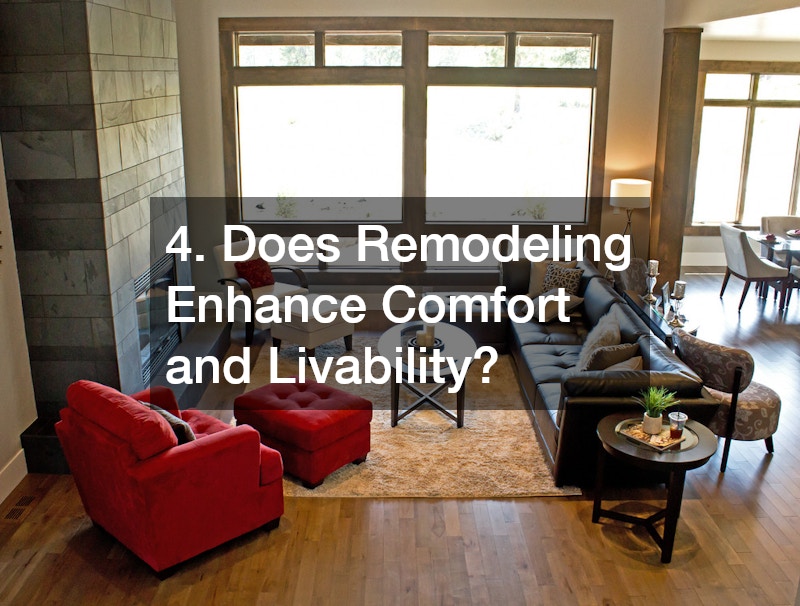10 Benefits of Remodeling Your Home

Home remodeling has evolved into a widespread practice in today’s real estate and interior design world. Homeowners no longer view it as just a means of refreshing outdated spaces; instead, they are recognizing remodeling as a strategic investment that can yield both immediate and long-term rewards. Whether the motivation is to boost the home’s value, improve livability, or adapt it to a modern lifestyle, remodeling offers a multitude of advantages. From rising home prices to an increased focus on personal comfort and environmental sustainability, the demand for home remodeling services is higher than ever. According to recent trends, more homeowners are choosing to renovate their current homes instead of moving to a new one, especially as the costs of purchasing new properties continue to rise.
The following article will delve into the many benefits of remodeling your home, ranging from increased property value to better functionality and enhanced safety. We’ll explore how remodeling can improve the overall experience of living in a home, make it more environmentally friendly, and contribute to the emotional satisfaction of owning a space that reflects one’s personal tastes and lifestyle. Whether you’re considering a small upgrade or an extensive remodel, the insights shared here will help you understand why home remodeling is a valuable investment.
1. How Does Remodeling Increase Your Home’s Value?

One of the most significant benefits of home remodeling is its ability to increase the market value of a home. Whether you’re planning to sell your house soon or just want to make it more appealing to future buyers, remodeling can help elevate your property’s worth. Certain home improvements have proven to yield a high return on investment (ROI).
Upgrades like modernizing the kitchen or bathroom, adding a new master suite, or finishing a basement or attic are all common ways to boost property value. For instance, a kitchen remodel, particularly one that includes high-quality cabinetry, modern appliances, and a fresh coat of paint, can increase the resale value of your home by as much as 50% of the renovation costs. Working with a reputable cabinet company to install custom cabinetry can transform an outdated kitchen into a stylish and functional space, a feature highly sought after by potential buyers.
Additionally, curb appeal plays a pivotal role in a home’s market value. Simple updates like fresh exterior paint, landscaping, or new siding can give your home a modern look, enticing buyers from the moment they approach the property. Local painters who specialize in both interior and exterior home painting can help elevate your home’s exterior appearance and make a significant impact on first impressions.
Ultimately, the remodel should match the market’s expectations in your area. While adding luxury finishes might work in high-end neighborhoods, more cost-effective updates may be the way to go in more modest communities. Therefore, when planning a remodel, it’s important to strike a balance between upgrading to increase your home’s value while maintaining practicality and staying within your budget.
2. What Are the Financial Benefits of Home Remodeling?
Beyond the immediate increase in property value, remodeling your home can also have several financial benefits that extend over time. One of the primary financial advantages is the ability to save money on maintenance costs. Remodeling projects, such as upgrading your home’s plumbing, electrical systems, or HVAC systems, can help prevent expensive repairs in the future. For example, installing new plumbing systems can avoid the costs of dealing with leaks, water damage, or outdated pipes that could otherwise lead to more costly problems down the line.
Energy efficiency is another financial advantage that comes with remodeling. By incorporating energy-efficient systems and materials into your remodel, you can significantly lower your monthly utility bills. Many homebuyers are now actively looking for homes that have been renovated with sustainability in mind. Upgrades like LED lighting, Energy Star-rated appliances, and better insulation can reduce your energy consumption, contributing to long-term savings.
Working with experienced contractors and suppliers, such as a cabinet company offering energy-efficient designs or a local supplier of sustainable materials, can help you achieve both aesthetic goals and functional, cost-saving solutions. Many energy-efficient upgrades, such as smart thermostats or high-efficiency windows, often have rebates or tax incentives, helping offset some of the initial costs.
3. How Can Remodeling Improve Your Home’s Functionality?
Functionality is one of the top reasons homeowners opt for remodeling your home. As family dynamics, work-from-home situations, and personal preferences change, your current home layout may no longer serve your needs. Remodeling offers an opportunity to address these evolving requirements.
For example, creating additional storage space or reconfiguring rooms can make your home more functional. Installing custom cabinetry in the kitchen or bathroom can improve organization, free up counter space, and make your home more efficient overall. Similarly, if you find that certain areas of your home are underutilized, such as an unfinished basement or attic, remodeling these spaces can provide a much-needed upgrade to enhance their functionality.
Upgrades can also include improvements to existing systems, such as more efficient plumbing or electrical systems, to enhance the overall operation of your home. A plumber or electrician can install features that simplify daily life, like low-flow fixtures to conserve water, new electrical outlets in convenient locations, or advanced lighting systems that increase the usability of each room.
4. Does Remodeling Enhance Comfort and Livability?

Comfort and livability are central to the appeal of any home, and remodeling can drastically improve both. Homeowners who invest in remodeling often do so with the goal of making their home more enjoyable to live in. Updates like replacing worn-out flooring, enhancing lighting, and creating open spaces contribute significantly to the home’s overall comfort.
Renovating spaces like bedrooms, bathrooms, and living rooms can transform them into relaxing sanctuaries. Installing hardwood flooring throughout the home not only adds warmth and style but also creates a more comfortable environment. Additionally, choosing the right colors and materials for each room can have a direct impact on how comfortable it feels. Professional house painting services can help ensure that the color palette used throughout the home complements your desired mood, creating a space that feels peaceful and inviting.
For many homeowners, creating an open and airy atmosphere is a key remodeling goal. Expanding walls, replacing heavy curtains with lighter fabrics, or adding large windows can make rooms feel more expansive and bright. Such upgrades are benefits of remodeling your home because they improve the home’s livability by reducing feelings of confinement and boosting the overall atmosphere of the space.
5. How Can Remodeling Enhance Safety and Security?
Remodeling is an excellent opportunity to address any safety concerns within your home. Whether it’s upgrading electrical systems, installing security cameras, or adding fire-resistant materials, thoughtful remodeling can enhance your home’s security and overall safety.
Home improvements aimed at increasing safety might include replacing outdated electrical wiring to meet current safety standards, installing non-slip flooring in wet areas, or upgrading windows with better locking mechanisms. Another important upgrade could be installing motion-sensing lights around the exterior of the home to deter break-ins or improve visibility at night.
Upgrading kitchens and bathrooms with durable materials, such as countertops from a granite counter supplier, can not only enhance the aesthetic appeal of the space but also reduce the likelihood of chips or cracks that could lead to injury. By investing in safety-focused remodels, homeowners create a more secure living environment for themselves and their families.
6. Are There Environmental Benefits to Remodeling?
In recent years, environmental consciousness has become a major driver for homeowners considering renovations. Home remodeling offers an opportunity to reduce your home’s carbon footprint and make more sustainable choices. From selecting eco-friendly materials to upgrading to energy-efficient appliances, the environmental benefits of remodeling are numerous.
For example, replacing old windows with energy-efficient ones can reduce heat loss, minimizing the need for excessive heating or air conditioning. Upgrading to a more efficient HVAC system can improve energy efficiency while reducing your home’s overall energy consumption. Likewise, choosing sustainable flooring options, like bamboo or reclaimed wood, or working with a ceramic floor tile installer who uses eco-friendly materials, helps create a home that is both stylish and environmentally responsible.
Additionally, remodeling projects that reduce water consumption, such as installing low-flow toilets or water-saving faucets, can significantly contribute to environmental conservation. Homeowners can also install solar panels or energy-efficient lighting, ensuring that their remodeled home operates in harmony with the environment.
7. Can Remodeling Foster Community and Family Connections?

A home that is tailored to foster social interaction and family bonding can enhance the quality of life for everyone who lives there. Whether you have a growing family, a busy lifestyle, or just enjoy hosting friends and family, remodeling can help create spaces that encourage connection.
For instance, an open-concept floor plan that integrates the kitchen, dining, and living areas creates a more social atmosphere. The kitchen often becomes the heart of the home, so updating it with functional yet stylish elements, such as modern appliances, a central island, or a breakfast bar, can facilitate interaction while cooking, dining, or entertaining. Visit a local furniture store to find some new pieces for your place.
Moreover, if you’re looking to create spaces for recreation or relaxation, remodeling a basement or outdoor patio can provide a perfect venue for family gatherings, game nights, or summer barbecues. These shared spaces improve the overall livability of a home, creating areas where memories are made and connections are strengthened.
8. How Can Remodeling Reflect Personal Style and Taste?
Your home is an extension of your personality, and remodeling provides the perfect opportunity to reflect your personal tastes, preferences, and lifestyle. Whether you prefer contemporary, rustic, or eclectic designs, remodeling enables you to bring your unique vision to life.
From selecting high-end ceramic tiles that match your aesthetic to incorporating bold colors or textures, the remodeling process is a chance to infuse your personal style into every room. If you’re working with an experienced contractor or designer, they can help you select the best materials, colors, and finishes that align with your vision.
Personalization in a home remodel doesn’t just make the space more enjoyable to live in—it also creates a sense of pride. A benefit of remodeling your home is that it creates a space that resonates with your individual style enhances the overall experience of owning it, making it a place where you truly feel at ease.
9. What Role Does Remodeling Play in Technological Upgrades?
As technology continues to advance, home remodeling has adapted to integrate the latest innovations. Smart home features are no longer a luxury—they are quickly becoming a standard. Remodeling can be a great way to incorporate these technologies into your home, making it more efficient, secure, and convenient.
From smart thermostats and lighting systems to voice-activated assistants, modern homes are becoming increasingly automated. For example, having an electrical installation expert incorporate a smart home hub during your remodel allows you to control lighting, security, temperature, and even appliances with a simple voice command or a smartphone app.
Upgrading to energy-efficient appliances, such as refrigerators, dishwashers, or washing machines, can also help reduce your household’s energy consumption, further contributing to the efficiency of your home.
10. How Does Remodeling Address Accessibility and Convenience?

Remodeling can be especially important for homeowners who need to adapt their living spaces to their evolving needs. Whether it’s due to aging, disability, or changing family dynamics, making a home more accessible and convenient can enhance its usability for everyone.
Widening doorways, installing ramps, or making bathrooms more accessible with features like walk-in showers and grab bars can ensure that the home remains comfortable and practical for those with mobility issues. Similarly, a plumbing service can install fixtures that are easier to use, like lever-style handles or sinks at an appropriate height for wheelchair users.
Making your home more accessible doesn’t just cater to current needs—it also ensures the space is adaptable to future changes, helping homeowners remain in their homes longer without the need for costly renovations later.
Conclusion
The benefits of remodeling your home are endless. Whether increasing your home’s value, improving comfort and functionality, enhancing safety, or making it more sustainable, remodeling can create a positive impact on your life for years to come. Thoughtful home remodeling allows you to craft a space that meets both practical and emotional needs, enhancing your living experience while ensuring long-term satisfaction. By aligning your home’s design with your personal taste, incorporating modern technologies, and prioritizing sustainability, remodeling can truly transform your home into a place you love.


